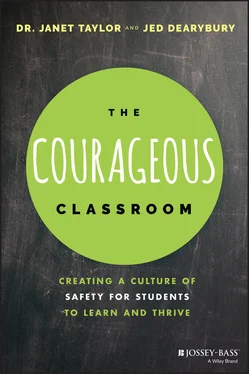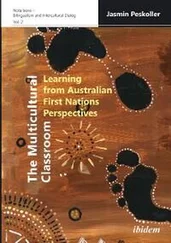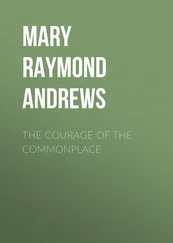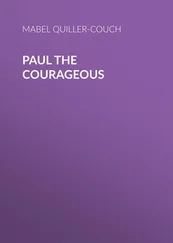To live courageously, we must build our inner resources. We must adopt a mindset based on our own self-awareness of what's happening in our lives at every moment, one focused on thriving not just surviving and rooted in successful adaptation to challenges instead of impulsive reactions. Our brain is wired for a courageous mindset, but it must be initiated by flipping on the switch of creative, curious thought.
What to Expect in This Book
The goal of Courageous Classrooms is to help both students and teachers interact in ways that promote a courage-based mindset, develop a positive adaptation to trauma and fear, and realize that courage in the face of fear within classrooms is a necessary choice. This book will utilize three principles to illustrate three truths for students and teachers:
1 the power of story and narrative for self-awareness;
2 the role of educators as encouragers of students; and
3 the importance of a courageous mindset.
The framework for the book is:
Teachers and students have stress, fearful experiences, and trauma.
Fear and trauma inhibit learning and contribute to anxiety-linked conditions.
Courageous classrooms promote healthy learning related to resolving conflict, eliminating bullying, and maximizing potential.
A fear response can be modified by fear extinction, fear reversal, and cognitive regulation of fear by attending to it (thoughts), regulating it (visual imagery), and choosing courage (persevering through fear).
Teachers who are encouragers (embodying and instilling more courage) provide appropriate encouragement to their students as an important mechanism in response to pain and to facilitate their growth and learning. They provide value in the interaction with their acceptance, attention, and affirmations; insight by being sensitive to a student's present emotional level and sharing that insight with the student; and challenge students to build on past learnings about how they successfully handled a situation, to keep trying as they think, grow, and take positive actions. Teachers who are encouragers also constantly re-evaluate their own skills with the goal of building courageous classrooms and their own self-efficacy.
At the heart of this work is a belief that teaching needs to be done with empathy, compassion, understanding, and love. It is written with the sincere wish that educators continue to work fearlessly, because the welfare, education, and safety of their students is their primary concern. Teachers wear many hats, including those of counselor, disciplinarian, role model, and a friendly shoulder to lean on. Managing their students, empowering them, and keeping them safe in the classroom and halls of the school while doing their primary job as educators is not easy. Teachers are on the frontline, weathering the storm of student fears while managing their own in times of stress, anxiety, and conflict. The courage of educators is a beacon of light that we need to continue to shine brightly for students, and Courageous Classrooms will promote creativity, communication, compassion, confidence, freedom, connectedness, and courage over fear. Read and join the movement of courageous classrooms. Start a conversation.
Chapter 1 The Brain's Fear System
Fear Is Normal
Fear is a normal part of psychological development for infants and children and critical to our survival across the lifespan. At every developmental stage, conquering fear allows children to grow, take risks, be adventurous, remain open to possibilities, and stay curious. Traversing through life is dependent upon the brain identifying patterns of familiar associations that may signal a dangerous outcome versus safety, and the ability to update those associations as our circumstances change. Fear is the associated learning of memories and the emotional and internal response generated by them. As we grow and develop throughout our lives, fear learning (distinguishing between what's safe and/or dangerous) and the ability to overcome or adapt to fear (fear extinction) by diminishing, reversing, or cognitively controlling fear as our circumstances change, is important to our survival, growth, and learning.
Infants learn early from their caregivers the necessary cues of who may be a threat and who is safe and who needs to be kept around. Infants learn early how to recognize and remember their caregiver by how they are touched, what they hear, smell, and can see (Debiec and Sullivan 2017). The quality and characteristics of those interactions shape infant behavior and physiologic response early on. Psychologist John Bowlby theorized that an attachment relationship to at least one primary caregiver is the most important aspect of social and emotional learning for a child. Attachment learning begins at birth and so does the learning of fear.
Caregivers can trigger a fear response in infants and children through social referencing. Social referencing refers to how a child uses caregiver cues to evaluate certain situations, like when a stranger comes close. Studies show that infants are very sensitive to a caregiver's emotional state, including fear and anxiety and readily pick up on it. From birth, we are primed to both attach for safety to our caregivers, learn about fear from them, and practice behavior that promotes our survival. Students utilize the same cues from teachers.
As children get older, what they fear may change. While younger children might fear the dark or scary monsters, older kids will shift to current events, like Covid-19, car accidents, or a family member being hurt. Our kids are always paying attention to what we discuss as adults and they sense what we are afraid of. Too much unmonitored time watching the news or being on social media without the context of feeling safe by having a discussion with their parents or teachers may increase children's fears by contributing to uncertainty and feeling unprotected.
Children will process fear depending on their age, the intensity and duration of exposure to a threat or image, and context. As adults do, children will use a variety of coping behaviors when dealing with a fearful event. Children may want to cuddle more or be clingy, try to take control of the situation by asking questions to understand, or cry and disengage. They reach for reassurance or safety by turning to a familiar face or favorite stuffed animal – all normal responses.
Although fear has been described by some researchers as a “childish emotion” that must be repressed in order to be considered mature, fear is not an emotion: it's a sensory and an evolutionary response that generates emotions. Fear is a brain and body phenomenon that connects our internal and external experiences to keep us safe. When a mother scares her child by screaming at him to not run out into traffic, the combination of being startled by her voice and actions will generate a fear memory (utilizing his senses, inner feelings, and being startled) that will be retained and direct him to look both ways when crossing the street. Now jump back thousands of years, and replace “traffic” with a hungry lion, and fear response begins to make a lot of sense.
Avoiding being eaten by predators is an early evolutionary task of animals and humans. Basic survival is one of the most cogent demands in the ecosystem. The neurophysiology of both our body and brain for survival has been engineered and adapted over time for one reason … staying alive . Charles Darwin, a biologist and geologist known for his writings about our human struggle for existence through natural selection, said, “Organisms unable to adapt to the demands of their environment will fail to pass on their genes and fall as casualties in the ‘war on nature’” (Darwin 1871).
Читать дальше












